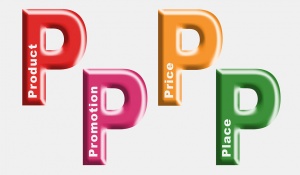
The Marketing Mix
The marketing mix is an important business tool used in marketing and by marketers. The marketing mix, a concept originally coined by Neil Borden, can be valuable when determining a product or brand’s offer, and is often associated with the four Ps (originally proposed by Professor E. Jerome McCarthy in the 1960s). The 4Ps help determine how marketing can satisfy consumer needs, which tend to change over time.
The “4Ps”: Controllable Market Risk Factors
The “4Ps” are considered controllable marketing mix factors (i.e., they can change or be altered as needed). Habits, lifestyle, and diet are all considered to be controllable risk factors.
- Product is the first P representing the actual product.
- Price represents the process of determining the value of a product.
- Place represents the variables of getting the product to the consumer such as distribution channels, market coverage, and movement organization.
- Promotion is the process of reaching the target market and convincing them to buy the product.
Marketers use the 4Ps to determine the proper strategy for a product or service. For example, if an Internet startup tech firm came to you with a proposal for a new social media analytics platform, you would have to answer important questions:
- How would you sell it, and where?
- How would you define the attributes of the product (in relation to the competition)?
- How would you identify and qualify complementary services?
- How would you research key customer segments to determine an appropriate price / benefit offering?
Answering each of these important questions requires an in-depth exploration of the “4Ps” to guide you to market success.
Uncontrollable Market Risk Factors
In addition to the marketing mix factors that can be controlled, there are uncontrollable factors that affect the implementation of market strategies, and how marketers are able to adapt to new challenges and changes (including customer needs and wants). Each market risk factor can have a significant impact and expense on marketing efforts. Risk factors can include:
- Regulatory: Laws, bylaws, regulations and governmental policies that may affect how marketing efforts can be implemented. For example, governments may restrict the importation of specific products or their use by a certain segment of the population (e.g. children under 18).
- Economic: Key trends in the economic business cycle, including inflation, recessions, deficit, or income level and spending power.
- Social: Dynamics of individuals and groups and their behaviours, values, beliefs, thought patterns, lifestyles, friendships, etc.
- Political: The governmental impact on bureaucracy, corruption, freedom of speech and other limitations (or opportunities).
- Competitive: The number of similar competitive products or services. A new competitor entering the market directly affecting the marketing strategies of the incumbent companies. Firms offering similar services or products often achieve differentiation through marketing, positioning and branding.
- Technological: The impact of technology advances for finished products, manufacturing, production, delivery and more.
The purpose of this learning pathway is to help you:
- Analyse the “4Ps” of marketing, i.e. product, price, place and promotion
- Describe the stages of the product life cycle
- Outline the controllable and uncontrollable factors that can influence marketing strategy
- Identify an appropriate marketing mix for a particular product or service
The marketing mix is an important business tool used in marketing and by marketers. The marketing mix, a concept originally coined by Neil Borden, can be valuable when determining a product or brand’s offer, and is often associated with the four Ps (originally proposed by Professor E. Jerome McCarthy in the 1960s). The 4Ps help determine how marketing can satisfy consumer needs, which tend to change over time.
The “4Ps”: Controllable Market Risk Factors
The “4Ps” are considered controllable marketing mix factors (i.e., they can change or be altered as needed). Habits, lifestyle, and diet are all considered to be controllable risk factors.
Marketers use the 4Ps to determine the proper strategy for a product or service. For example, if an Internet startup tech firm came to you with a proposal for a new social media analytics platform, you would have to answer important questions:
Answering each of these important questions requires an in-depth exploration of the “4Ps” to guide you to market success.
Uncontrollable Market Risk Factors
In addition to the marketing mix factors that can be controlled, there are uncontrollable factors that affect the implementation of market strategies, and how marketers are able to adapt to new challenges and changes (including customer needs and wants). Each market risk factor can have a significant impact and expense on marketing efforts. Risk factors can include:
The Marketing Mix
The purpose of this learning pathway is to help you:
Content is available under the
Creative Commons Attribution Share Alike License.
Privacy Policy | Authors